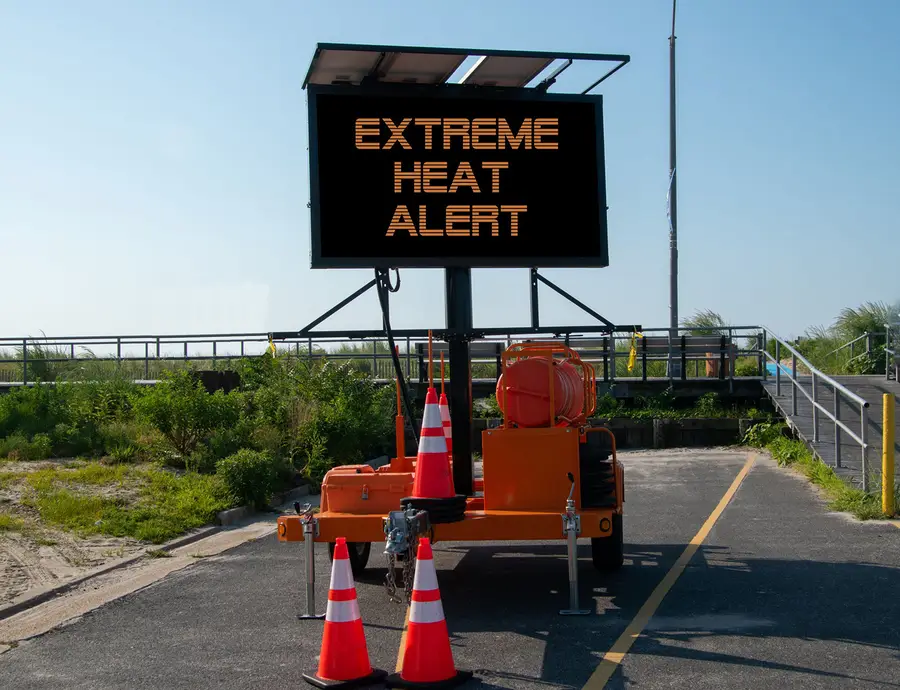
Hottest year, hottest month, hottest day. As heat records topple in the summer of 2024, we are directly experiencing the effects of climate change. It’s not a problem of the future; it’s a problem of today. It’s here, and it’s taking a deadly and costly toll. Extreme heat strikes relentlessly and indiscriminately, claiming the lives of more than 1,300 Hajj pilgrims in Saudia Arabia alone. Elsewhere, high temperatures had howler monkeys dropping dead from the trees in southern Mexico, crops sizzling in Asia, and a highway buckling in West Virginia, to name just a few of the widespread impacts.
This summer’s heat has been so brutal that it prompted UN Secretary-General Antonio Guterres to proclaim an “extreme heat epidemic” and renew his calls to fight the twin “diseases” of climate inaction and addiction to fossil fuels. The intense heat that Guterres aptly termed a “silent killer” has been responsible for at least 489,000 deaths per year from 2000-2019, as reported in The Lancet, and that figure is projected to increase by 370% if the effects of global warming aren’t contained. Economic losses from heat stress at work, particularly agriculture and construction, are estimated to reach $2.4 trillion by 2030.
A flurry of activity has surfaced to form coalitions, analyze extreme heat, and study adaptive strategies. RTI is actively collaborating with communities on local adaptation, which is necessary and critical to safeguard livelihoods across the globe. However, there are limits to adaptation. As we experience this unprecedented rise in temperature, it is important to remember the fossil fuels at the center of global warming.
The Cascading Effects of Extreme Heat
As temperatures soar this summer, we can better grasp in real time the interrelated and domino effects associated with extreme heat, just one aspect of climate change. For example, heat contributes to drought, which worsens wildfires and hastens their spread, volatility and intensity. It compounds the misery wrought by natural disasters, like Hurricane Beryl, which recently left millions of Texans without electricity to power air conditioning, causing dozens of heat-related deaths. High temperatures also impact education as schools without AC are forced to close in many parts of the world during heat advisories.
Extreme heat threatens global food security. Crop yields are reduced, dairy cows produce less milk, and livestock are slow to gain weight when temperatures are high, compounding the drag on agricultural productivity and crop nutritional quality already linked to rising levels of carbon dioxide in the atmosphere. To lessen their risk of heat stroke, some farm workers have begun harvesting at night.
Heat has other adverse impacts on human health, exacerbating existing conditions like diabetes, asthma, and kidney disease, all of which place additional demands on the health care system. Extreme heat is already responsible for the highest number of annual deaths among weather-related hazards, both globally and in the U.S. It disproportionately affects the most vulnerable, with heat-related deaths increasing by 85% for persons over age 65 between 2000–2004 and 2017–2021. RTI is conducting new research documenting the role of extreme heat in worsening infant mortality and maternal health.
Our natural environment is also responding to extreme heat, as changing conditions push wildlife into new areas. RTI has documented that mosquito-borne diseases, such as dengue and malaria, are surging as warmer temperatures and more intense rainfall make it easier for the insects to breed and expand their range. The world’s oceans are warming as well, which reduces their ability to serve as critical carbon sinks and support corals and other marine life.
Essential Climate Action: Adaptation and Mitigation
In most areas of the world, we’ve been able to manage heat through modifications to our current infrastructure and lifestyles. Adaptation solutions require close collaboration with local communities to analyze climate impacts and develop interventions. Some of the more novel approaches are nature-based solutions that provide multiple benefits, such as mangroves that can slow coastal erosion while sequestering carbon and protecting biodiversity. RTI supports the U.S. EPA with research on how to measure the vulnerability of communities to extreme events, including extreme heat and other climate risks, especially when these communities are near contaminated sites and waste management facilities that may release harmful contaminants because of these events. This research has helped cities such as Phoenix to account for these risks and allocate resources toward areas that may be most impacted. RTI research has also found that increasing tree cover in cities is an effective adaptation strategy against extreme heat, with proven reductions in heat-related deaths.
With this summer’s spate of scorching temperatures, it seems a threshold to adaptation is close. Since July 2023, Earth’s average temperature has consistently exceeded 1.5 degrees Celsius above preindustrial levels — the target scientists set for avoiding the worst impacts of global warming. With this bitter taste of a hotter future, we are realizing that many human and environmental systems simply can’t keep up with the escalation of extreme weather events. If the heat continues — as it will, without our direct and rapid intervention — the ability of these systems to recover will be weakened
Clean energy mitigates the amount of carbon going into the atmosphere to provide much needed electricity, including supporting vulnerable populations with adaptation actions such as additional cooling technology. RTI’s work with Power Africa, including the Empowering East and Central Africa Project, shows how clean renewable energy sources can be mobilized to provide people with essential access to affordable electrical service -- without increasing carbon emissions. Improved energy efficiency and design techniques (e.g., cool roofs, shading) provide complementary strategies to reduce the need for energy in transportation, buildings, industrial, and water and sanitation sectors.
Promising Signs to Mitigate Climate Change and Extreme Heat
Many countries have already shown that it’s possible to reduce carbon emissions on a large scale. For example, solar, wind, hydroelectric, and geothermal renewable sources generated 85-90% of Kenya’s power in 2023, while Uruguay weaned itself off imported oil by transitioning to renewable sources, primarily wind and hydropower, to generate 98% of its electricity.
At last year’s Conference of Parties (COP) on climate, an international meeting that’s been convening for 28 years now, there was a call for the complete phase-out of fossil fuels. While unsuccessful, the call is expected to become louder and hopefully succeed in upcoming negotiations. Discussions of the cost of inaction and of the missed financial opportunities of climate change action are also growing. U.S. Treasury Secretary Janet Yellen recently highlighted the possible financial opportunities in transitioning to a low-carbon economy, which she estimates will require $3 trillion in new capital annually through 2050.
This summer’s historically hot temperatures underscore the absolute urgency for climate action now. If we’re already suffering, and more warming is likely even under the best-case scenario, it’s obvious we have no time to waste.
Learn more about RTI’s Center for Climate Solutions

